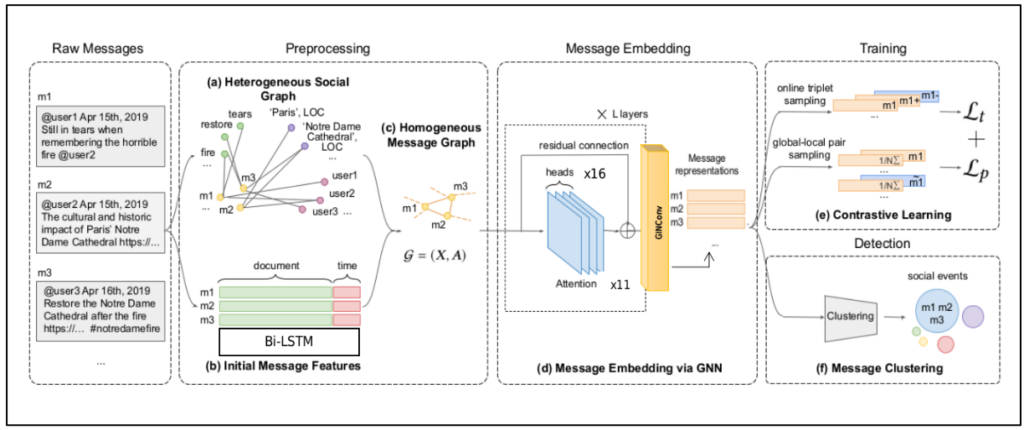Social Event Detection using GNN
In this project, we dive deep into the ocean of deep learning to enhance the results of Knowledge-Preserving Incremental Social Event Detection via Heterogeneous GNNs! We’ll be working with the KPGNN model, bolstering it with BERT/LSTM embeddings and Graph Isomorphism Convolution (GInConv) layers. This fusion of natural language processing and graph neural networks can bring a new depth to social event detection.

Completion Date: May 2023 | Tools: Pytorch, Tensorflow, Flask

Introduction
The project of Social Event Detection using GNN represents a sophisticated amalgamation of deep learning techniques aimed at incrementally detecting social events via Heterogeneous Graph Neural Networks (GNNs). This initiative, leveraging the KPGNN model with BERT/LSTM embeddings and Graph Isomorphism Convolution (GInConv) layers, strives to revolutionize the way we understand and respond to online social trends. This case study delves into the challenges, solutions, and implications of this pioneering endeavor.
The Challenge
- Dynamic Nature of Social Events: Social media platforms are constantly evolving, with new trends and events emerging rapidly. The challenge lies in capturing these dynamic shifts accurately and efficiently.
- Integration of Textual and Graph Data: Combining natural language processing (NLP) with graph data to understand and identify events within the vast social media landscape presented a complex problem.
- Knowledge Preservation: Incremental event detection required a model that not only recognizes new events but also maintains a robust understanding of past events. Balancing these two needs was a major challenge.
- Scalability Across Platforms: The solution had to be adaptable and effective across various online platforms, each with unique characteristics and user behaviors.
What We Did to Solve the Challenge
- Incorporated KPGNN with BERT/LSTM embeddings: Utilizing the Knowledge-Preserving Incremental GNN (KPGNN) model and enhancing it with BERT/LSTM embeddings ensured nuanced text understanding along with graph analysis.
- Introduced Graph Isomorphism Convolution (GInConv) Layers: Implementing GInConv layers allowed the model to adapt to the unique structure of social media graphs, identifying patterns and connections that signify social events.
- Designed an Incremental Learning System: The model was built to continually learn from new data, capturing emerging trends without losing sight of historical events. This was pivotal in preserving knowledge.
- Optimized for Cross-Platform Performance: Careful consideration and tuning ensured that the solution would perform effectively across a variety of online platforms, reflecting the diverse nature of social media.
Impact and Conclusion
The Social Event Detection using GNN project represents a paradigm shift in how we approach the analysis of online social interactions:
- Revolutionizing Real-Time Trend Analysis: By accurately identifying emerging social events, businesses and researchers can gain real-time insights into what’s trending, enabling timely and informed decisions.
- Enhancing Disaster Response Systems: Timely detection of events related to natural disasters or emergencies can enable quicker, more effective response measures, potentially saving lives and resources.
- Empowering Event-Driven Marketing Strategies: Marketers can leverage the insights from this model to craft timely, targeted campaigns that resonate with current social sentiments and trends.
- Democratizing Data Intelligence: The project opens new avenues for analysts, policymakers, and organizations to understand social behavior, transforming seemingly chaotic online chatter into structured, actionable insights.
The Social Event Detection using GNN project signifies an extraordinary stride in the ongoing journey to decode the complex tapestry of social media. By turning online interactions into discernible patterns and meaningful information, this project stands as a testament to the evolving capabilities of AI and deep learning.
In a world where online interactions shape perceptions, opinions, and decisions, this project holds the promise of transforming virtual noise into symphonies of understanding and innovation. It’s a bold step toward making sense of our interconnected digital age, and the ripples of its impact are likely to be felt across various domains for years to come.

